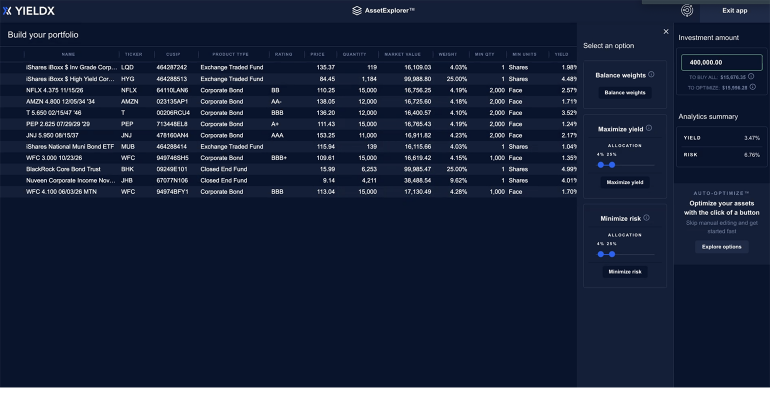Fresh off another round of $5 million in seed funding, fixed income intelligence and portfolio management platform YieldX announced its general availability to advisors, broker/dealers and family offices, among other clients. The company has been in private beta since June.
The startup has three features designed to facilitate fixed income selection and trades. AssetExplorer is its analytics tool to identify and screen fixed income assets; BestFit lets users construct a customized portfolio of corporate and municipal bonds; and InPaas is an algorithm-based feature for balancing income or yield target goals against risk and expense ratios.
The company is led by CEO Adam Green, co-founder of MoneyLion, and President and Chief Innovation Officer Steve Gross, formerly founder and CIO at AlphaParity (acquired by Franklin Templeton). YieldX raised $5 million in seed funding in April 2019 and closed another round of $5 million two weeks ago, according to Green.
AssetExplorer shows users the universe of fixed income securities, sourcing assets from market makers’ trading floors and alternative trading systems. Filters allow users to sort for liquidity and large banks are not paying for order flow or transactions, said Green.
BestFit lets users input specific conditions, such as maturity, weighting and ESG factors, to build end-to-end bond portfolios, he explained.
InPaas marries risk management with automated rebalancing and yield targets. In that way, if yield hits certain high or low thresholds in a cycle, the rebalancing algorithm will be triggered and suggest trades for maintaining targets. The feature can also be used to generate an ETF or closed-end fund portfolio optimized for expense and risk.
YieldX is not designed to replace a portfolio management system, said Christopher Gunderson, CEO of Amulet Consulting Group. Gunderson is on a consulting retainer with YieldX and has seen the product firsthand.
The new tool is “more of a complement to execution,” he explained. “While the YieldX platform does have an execution capability to get something done quickly and in one place, the core of the platform is fixed income search, analytics and portfolio building. Execution is not a primary driver of revenue for the YieldX team, so I can see trade execution providers perhaps wanting to partner up with them.”
Advisors who stand to benefit most from YieldX would be RIAs or family offices managing fixed income portfolios in-house; or those who currently outsource fixed income management, but want to move it in-house and are looking for the right tool to do so, he said. “They are going to realize immediate efficiencies in their construction process with better data and risk information,” Gunderson said.
Advisors who rely on fixed income tools offered by custodians will appreciate that YieldX casts a comparatively wider net when it comes to discovering and filtering assets, as well as providing a better interface for building portfolios, he continued. The tool is integrated with “several trading venues” and has “an easy export if [a] user wants to direct [a trade] to their custodian.” In that way, YieldX is designed to improve, not supplant, an advisor’s process for trading fixed income.
The advisors who will most benefit from YieldX, which costs $10,000 a seat, per year, for an enterprise license, will need to have a robust fixed income business, said Brett Fry, an advisor at Forteris Wealth Management in Dallas. Even with $112 million in AUM, according to its most recent regulatory filing, and a steady fixed income business, Fry estimates that a tool like YieldX would need to lead to $5 to $10 million in new assets, every year, to justify its costs.
Fry currently uses a combination of spreadsheets, widely available data—like the FINRA-developed Trade Reporting and Compliance Engine (TRACE)—and a broker network he’s cultivated, to execute his fixed income discovery, screening and execution.
For advisors who prefer to use fixed income ETFs, however, YieldX “looks promising,” according to Maya Tussing, an advisor at Fairlight Advisors in San Francisco. The two-advisor firm has $8 million in AUM, according to its most recent filing.
Tussing typically uses a combination of web-based screening tools, like Morningstar and ETF.com, to screen for fixed income funds. After manual analysis, she will make her investment decisions, she said. For her, YieldX “looks promising for what we do, particularly for our clients looking for shorter horizon portfolios.”
Advisors need better fixed income technology, said Dennis Gallant, senior analyst at Aite Group. "The tools sound very interesting and addresses a number of inefficiencies in the fixed income/bond marketplace for advisors," he said, while noting he had not had a chance to review the tool in detail or yet been briefed on it.
Advisors who use custodian platforms for their fixed income asset discovery and filtering are using an “inferior” platform, explained Tom Bradley, head of fixed income at YieldX. “We are using [a quantitative] and intuitive [user interface] to direct investors to the right assets. Most custodian platforms work in reverse, trying to fit inventory or products into a solution with inadequate search tools.”
The “API-first” company can integrate with firms like Orion, eMoney, Addepar and custodians, he added. YieldX executives are confident that their offering will entice advisors who may otherwise utilize ETFs and mutual funds for their clients’ fixed income investments.
“As equity markets become more volatile and investors begin more searches for yield, this is exactly the type of tech that advisors need to have,” said Green. “COVID showed that there’s a lot more automation that’s accessible than people were comfortable using before,” he added. “Fixed income is now ripe for automation.”





